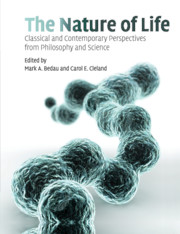Book contents
- Frontmatter
- Contents
- Preface
- Acknowledgments
- Sources
- About the authors
- Introduction
- SECTION I CLASSICAL DISCUSSIONS OF LIFE
- 1 De Anima (selections)
- 2 Treatise on Man
- 3 Critique of the teleological power of judgment (selections)
- 4 What is Life? (selections)
- 5 The nature of life
- 6 What is the meaning of “life”?
- 7 The principles of life (selections)
- SECTION II THE ORIGIN AND EXTENT OF NATURAL LIFE
- SECTION III ARTIFICIAL LIFE AND SYNTHETIC BIOLOGY
- SECTION IV DEFINING AND EXPLAINING LIFE
- Supplementary bibliography on life
- Index
7 - The principles of life (selections)
Published online by Cambridge University Press: 10 November 2010
- Frontmatter
- Contents
- Preface
- Acknowledgments
- Sources
- About the authors
- Introduction
- SECTION I CLASSICAL DISCUSSIONS OF LIFE
- 1 De Anima (selections)
- 2 Treatise on Man
- 3 Critique of the teleological power of judgment (selections)
- 4 What is Life? (selections)
- 5 The nature of life
- 6 What is the meaning of “life”?
- 7 The principles of life (selections)
- SECTION II THE ORIGIN AND EXTENT OF NATURAL LIFE
- SECTION III ARTIFICIAL LIFE AND SYNTHETIC BIOLOGY
- SECTION IV DEFINING AND EXPLAINING LIFE
- Supplementary bibliography on life
- Index
Summary
THE CRITERIA OF LIFE
Living and non-living systems are qualitatively different, i.e., living systems have qualitative properties or groups of qualitative properties which occur exclusively in the living world and cannot be found in the non-living world. In what follows, these common characteristics found in living organisms will be called life criteria, the laws uniting these characteristics will be considered the principle of life, and life itself as a common general abstraction of every kind of living being will be accepted as a philosophical and not a biological category. Life criteria will be dealt with in the present chapter, and the principle of life will be discussed in connection with the organization of the chemoton. Life as a philosophical category will not be dealt with in the present book.
The selection and axiomatically exact formulation of life criteria is of fundamental importance in theoretical biology. As we have seen, classical biology has not been able to solve this problem during its long history of 2000 years. We shall present here a quite new system of life criteria, which entirely differ from the classical “life phenomena.” This new system of life criteria was first proposed in the original edition of this book in 1971.* However, in the diverse world of biology it is not easy to select fundamentally common characteristics, since it is impossible to find a research worker who could claim to know every part of the living world with the required precision.
- Type
- Chapter
- Information
- The Nature of LifeClassical and Contemporary Perspectives from Philosophy and Science, pp. 102 - 112Publisher: Cambridge University PressPrint publication year: 2010
- 2
- Cited by



